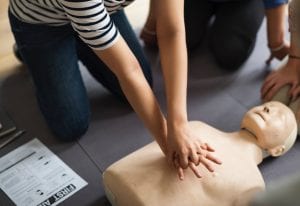The American Heart Association (AHA) has begun to offer courses in treating opioid addiction specifically for healthcare professionals and laypersons involved in emergency care.
The American Heart Association (AHA) is now offering two courses for healthcare professionals and laypersons regarding how to provide emergency care and treatment for opioid overdoses. The courses are titled Opioid Education for Healthcare Providers and Opioid Education for Non-Clinical Staff and Lay Responders. They are designed to teach the public and those on the front lines battling the addiction epidemic about the issue and what they can do to help someone who experiences an overdose from either prescription pain killers or street drugs such as heroin.
“Deaths from opioid overdoses – a direct corollary for respiratory and cardiac arrest in these patients – have reached crisis proportions and created the urgent need for science-based, standardized education,” the AHA website states.
The layperson option is self-directed and will include discussions regarding techniques such as the use of CPR and reversal agents. The healthcare provider course specifically created for medical personnel such as EMTs, paramedics, nurses, physicians, and other providers, will offer information about the opioid epidemic, opioid-use disorder, the pathophysiology of pain and opioids that lead to addiction, as well as complementary therapies.

“The American Heart Association is stepping into this crisis and filling the need in standardized education for healthcare professionals,” said Dr. Eduardo Sanchez, the Association’s chief medical officer for prevention. “Arming as many people as possible with up-to-date, practical knowledge on what to do– both immediately and as follow up — is imperative to saving lives and improving outcomes.”
According to the National Institute on Drug Abuse (NIDA), an estimated 115 people die daily from respiratory and cardiac distress resulting from an opioid overdose. The Centers for Disease Control and Prevention (CDC) estimates that the total “economic burden” of prescription opioid misuse alone in the United States is $78.5 billion a year.
NIDA’s website outlines the history behind the epidemic, stating, “In the late 1990s, pharmaceutical companies reassured the medical community that patients would not become addicted to prescription opioid pain relievers, and healthcare providers began to prescribe them at greater rates. This subsequently led to widespread diversion and misuse of these medications before it became clear that these medications could indeed be highly addictive. Opioid overdose rates began to increase. In 2015, more than 33,000 Americans died as a result of an opioid overdose, including prescription opioids, heroin, and illicitly manufactured fentanyl, a powerful synthetic opioid. That same year, an estimated 2 million people in the United States suffered from substance use disorders related to prescription opioid pain relievers, and 591,000 suffered from a heroin use disorder (not mutually exclusive).”
In addition to the two new courses, the AHA offers a wealth of resources on opioid use disorder on its website. It has also expanded its emergency cardiovascular care (ECC) guidelines to more adequately address the issue. The site indicates, “Experience with treatment of patients with known or suspected opioid overdose has demonstrated that naloxone can be administered with apparent safety and effectiveness in the first aid and BLS settings. For this reason, naloxone administration by lay rescuers and HCPs is now recommended, and simplified training is being offered.”
Sources:
Online course to facilitate improved outcomes of opioid overdoses
Heart Association offering online courses opioid overdose care


Join the conversation!